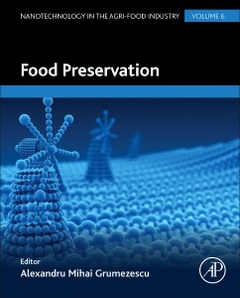Description
Food Preservation
Nanotechnology in the Agri-Food Industry Series
Coordinator: Grumezescu Alexandru
Language: English
Subjects for Food Preservation:
Keywords
active food packaging; adsorbing additive; agri-food industry; antimicrobial; antimicrobial agents; antimicrobial properties; antimicrobial surfaces; antimycotoxins; applications; aromatic compounds; assessment; bacteria; bacteriocins; biofilm; biofilms; biofouling; cellulose; citation classics; contamination; controlled release; copper nanoparticles; cyanobacteria; discharge; disinfection; drug delivery; equipment; essential oils; external factors; films; food; food and feed; food chemistry; food microbiological quality; food nanoemulsions; food nanoencapsulation; food nanopackaging; food nanopreservation; food packaging; food pathogens; food poisoning; food preservation; food samples; food-borne pathogens; food-contact surfaces; foods; foodstuff; fungi; gas plasma; high-intensity ultrasound; hygienic design; infectious disease; light; liposome; MALDI-MS; market; metal; metal sponges; metallic; multifunctional systems; multilayers; multiresistant; mycosporine-like amino acids (MAAs); nano-antimicrobials; nano-materials; nanobiotechnology; nanocellulose; nanocomposite surface; nanocomposites; nanoengineered solutions; nanofood industry; nanomaterials; nanoparticle; nanoparticles; nanoprocesses; nanosensors; nanostructurated materials; nanostructures; nanotechnology; nanotoxicology; natural products; nonfood contact surfaces; nonthermal treatment; oxygen; packaging; pathogens; physicochemical properties; plasma technology; polymer nanotechnology; polymeric; polyvinyl alcohol; porous surfaces; preservation; rapid methods; reactive oxygen species; safe food; safety considerations; Salmonella; sanitation; scientometrics; scytonemin
Support: Print on demand
Description
/li>Contents
/li>Biography
/li>Comment
/li>
Food Preservation, Volume Six, the latest in the Nanotechnology in the Agri-Food Industry series, discusses how nanotechnology can improve and control the growth of pathogenic and spoilage compounds to improve food safety and quality. The book includes research information on nanovesicles, nanospheres, metallic nanoparticles, nanofibers, and nanotubes, and how they are capable of trapping bioactive substances to increase and maintain the stability of compounds often sensitive under typical food processing and storage conditions. This book will be useful to a wide audience of food science research professionals and professors and students doing research in the field.
2. Food applications of nanostructured antimicrobials
3. Nanostructured antimicrobial materials in the food industry
4. Antimicrobial nanotechnology: Research implications and prospects in food safety
5. Sanitation of Equipment
6. Recent advances in gas plasma technology for decontamination of food surfaces
7. Use of high intensity ultrasound for production of antimicrobial and self-cleaning surfaces
8. Multifunctional antimicrobial nanocomposites for food packaging applications
9. Nanostructurated materials for prolonged and safe food preservation
10. Nanobiotechnological strategies for toxigenic fungi and mycotoxin control
11. Natural products used for food preservation
12. Use of nanoparticles as a potential antimicrobial for food packaging
13. Recent Advances in the Direct and Nanomaterials-based Matrix-assisted Laser Desorption/Ionization Mass Spectrometric Approaches for Rapid Characterization and Identification of Foodborne Pathogens
14. Nano-metals Appraisal in Food Preservation and Food-Related Activities
15. Photodamage and photoprotection: towards safety and sustainability through nanotechnology solutions
16. Nanoparticles and their potential application as antimicrobials in food industry
17. Nanobiotechnology of cyanobacterial UV-protective compounds: Innovations and prospects
18. Advances in molecular biology based assays for the rapid detection of food microbial contaminants
19. Antimicrobial Food Packaging with Cellulose-Copper Nanoparticles Embedded in Thermoplastic Resins
20. Scientometric overview in food nanopreservation
- Describes the effective utilization of nanostructured antimicrobials in toxicological studies and real food systems
- Offers research strategies for understanding opportunities in antimicrobial nanostructures and the potential challenges of their toxicity
- Presents diverse applications of nanostructured antimicrobials in food preservation
- Covers the potential benefits of nanotechnology and methods of risk assessment that ensure food safety




